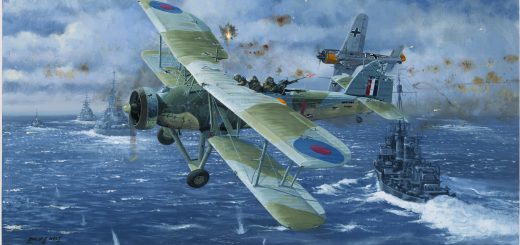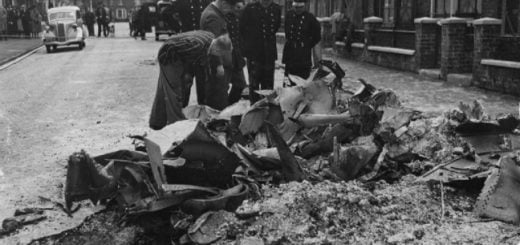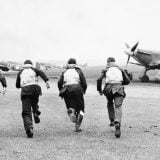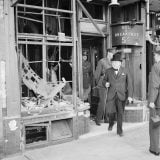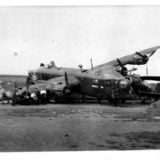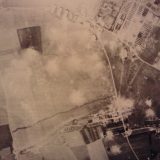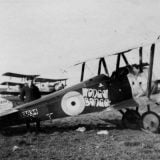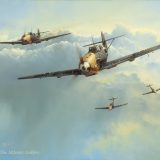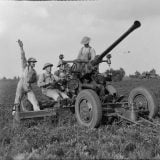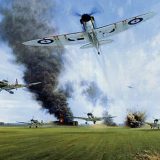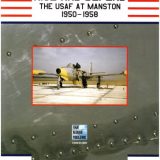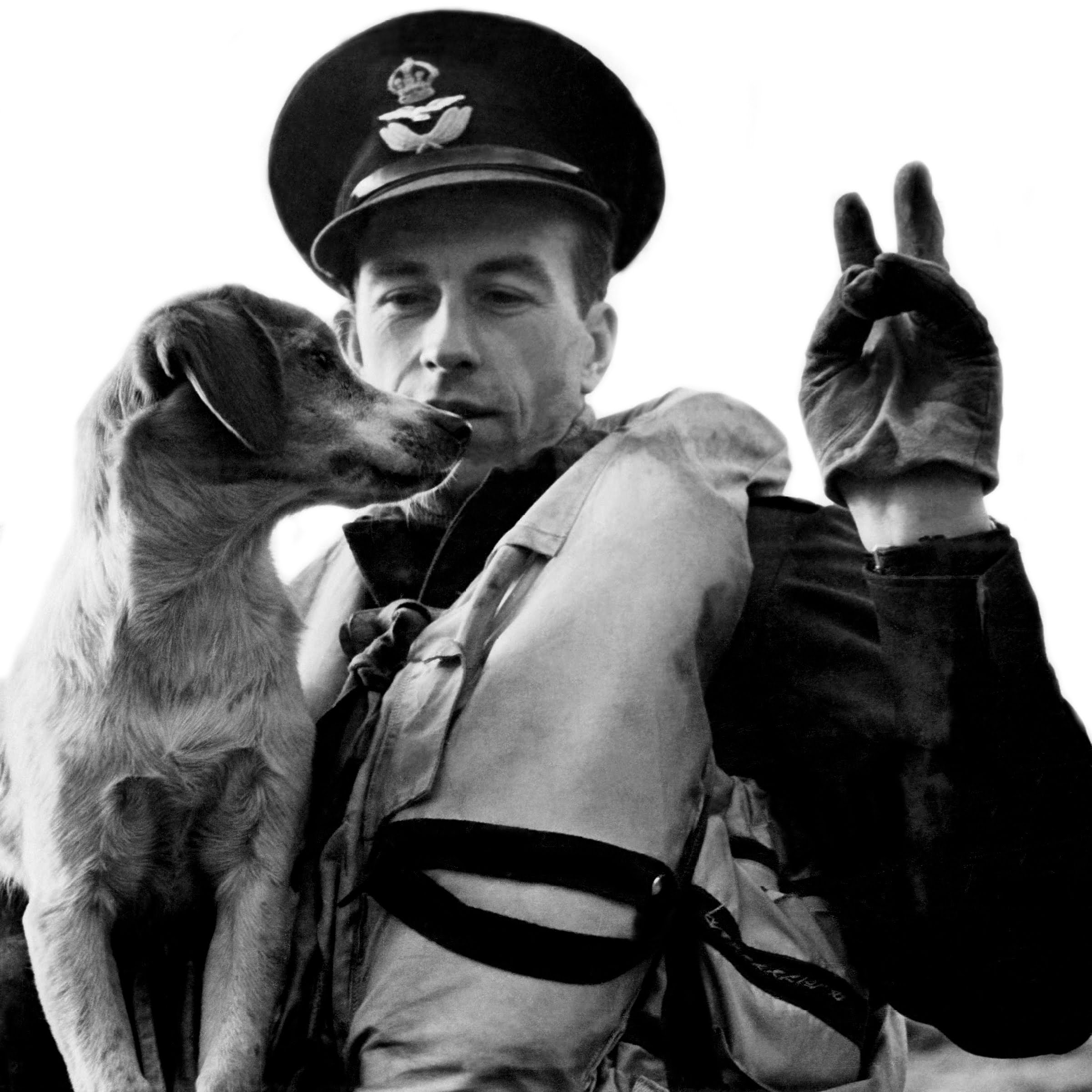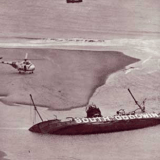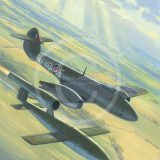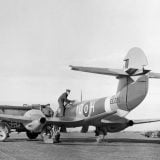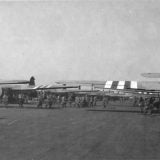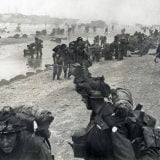Manston takes the full force of Luftwaffe attack against airfields, 12th August 1940
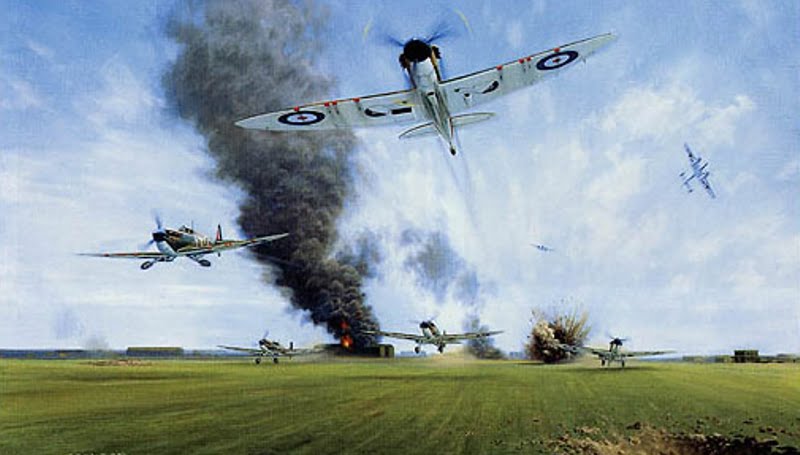
A depiction of No. 65 squadron taking off as the attack on Manston takes place.
Note: Unfortunately, time didn’t allow us to update this properly this year for the 2025 anniversary, but work is ongoing to try to add more information here.
12th August 1940 marked the first major raid inland against RAF airfields by the Luftwaffe and Manston was to feel the full force of the offensive. By the end of the day, Manston was left unserviceable. This was the Luftwaffe’s precursor for Adlertag, (Eagle Day) planned for 13th August, part of an offensive where they intended to wipe out the RAF in a few days to allow the invasion of Britain by Operation Seelöwe (Sea Lion) due to take place in September.
The operations that took place on the 12th would mark a dramatic escalation in what had gone before. Radar installations, convoys in the Channel and airfields were all targeted in a sequence of concentrated strikes designed to handicap and destabilise Fighter Command..
The Luftwaffe began with attacks first detected at 0840hrs on the high towers of the British radar stations by Messerschmitt Bf110s at Dover, Pevensey, Rye and Dunkirk near Canterbury. Dunkirk suffered only minor damage, but the other three were back on the air after just a few hours. Dover also sustained accurate long-range artillery fire from guns located on the coast of France, some 21 miles away.
In late morning, the attack turned to large formations of Stuka dive bombers against several small convoys in the Thames Estuary and attacks on other radar stations and naval bases.
No.65 Squadron scrambled in their Spitfires from Hornchurch to protect two small convoys passing North Foreland from reports of enemy dive bombers, but not before two ships had been sunk. Hurricanes from No.501 Sqn were dispatched from Biggin Hill.
Once the enemy had taken out the radar stations, their attentions turned to the destruction of the RAF airfields in Southern England, with Lympne, Hawkinge and Manston the first three on the list.
At 1250hrs the airfield at Manston was the first to be hit by Bf110 and Bf109s. All but one of No.65 Sqn’s Spitfires got into the air, hit just as they were taking off on a routine patrol, after returning to Manston at 1115hrs to refuel and rearm. The propeller on Pilot Officer Pilot Officer Kenneth Grahame Hart’s Spitfire (R6712 YT-N) was stopped by an explosion, with Hart surviving and the aircraft later repaired. Hart would later be killed on 28th December 1944 in Italy flying whilst flying Boston BZ557 as part of No.18 Squadron, after his promotion to Squadron Leader and he had been awarded a DFC.
Manston had become a key target, being the most easterly of all the airfields in the south and was, at the time, an all grass airfield, allowing entire squadrons to take off together, enabling them to be in the air and reaching the enemy quicker than if they had to take off in single file on a normal concrete runway.
RAF Manston Station Operations Record Book
At 1250 hrs the aerodrome was heavily attacked by approximately fifteen Me110's and some Heinkel's and bombed at low altitude; some 150 HE bombs were dropped; the aerodrome was pitted with approximate 100 craters and rendered temporarily unserviceable; two hangars were damaged, and workshops were destroyed; in the latter building a civilian clerk was killed, this being the only fatal casualty; the raid lasted approximately five minutes.
Aircraftman Seymour, Leading Aircraftman Whatley and Sergeant Gifford, seemingly of No.600 Squadron and Aircraftman C E Madigan were among the injured. However the Squadron records suggest there were no casualties in the Squadron, so something we will try to clear up in the future.INTELLIGENCE PATROL REPORT (from AIR 27/596)
Combat of 65 Squadron at 13.00 hours on 12/8/1940
The Squadron was operating from MANSTON and at 12.45 hours were ordered off the ground to intercept raiders.
Only 11 aircraft took off as Sergeant Kilner had not time to change his oxygen tube from the last sortie.
As the aircraft took off the aerodrome was attacked by dive-bombers – about 12 aircraft, DO.17’s and ME.110’s, and as the last of our fighters took off (P/O Hart), a small bomb burst about 30 feet below him, the displacement of air somehow caused his engine to stop and he had to land. The aircraft was however undamaged and was able to take off after the raid.
By the time the remaining aircraft had formatted, the bombers were out of sight and the Squadron climbed to 6,000 feet where some stray ME.109’s were sighted, diving in and out of the clouds. 2 of these were engaged, one by P/O Gregory who followed the e/a well out to sea, and another by F/O Smart who fired and damaged the e/a but was unable to continue the attack after losing the e/a in cloud. The rest of the Squadron flying at 10,000 feet over MANSTON sighted 25 – 30 bombers at about 12,000 feet.
While climbing to attack, the Squadron Leader saw a Squadron of fighters at 15,000 feet and considered it policy to investigate these first. They proved to be Hurricanes and by this time the bombers were out of sight.
Later a formation of 30 ME.109’s in vics of 5 in line astern were seen approaching at 30,000 feet, but on sighting the squadron turned back and were not contacted.
The 15 ME.109’s were engaged at 15,000 feet and the rearmost aircraft was engaged by P/O Finucane as it attempted evasion behind a cloud. The rest were lost in cloud; markings on all aircraft were distinct, with white bands round the crosses, and camouflage was the usual silver. No fire was encountered.
THE RESULT OF THE COMBAT WAS AS FOLLOWS :-
P/O Gregory rounds fired 2670 1 ME.109 Destroyed (Probable)
P/O Finucane rounds fired 1280 1 ME.109 Destroyed (Probable), 1 ME.109 Damaged.
F/O Smart rounds fired 1400 1 ME.109 Damaged.
F/O Nichalas rounds fired 920 )
F/O Quill rounds fired 480 ) Engaged 1 ME.109 (NO CLAIM)
P/O Pyman rounds fired 2450 )
OUR OWN CASUALTIES – NIL
The Squadron was ordered to land at ROCHFORD at 1348 hours, the 2 a/c which remained at ROCHFORD followed 10 minutes later.No.600 Squadron Operations Record Book
(Manston, Bristol Blenheim, Form 540 - Summary, AIR 27/2059/15)
The first heavy bombing attack on the aerodrome did a certain amount of damage to the aerodrome surface, 150 or so bombs being dropped. Hangars on the far side of the aerodrome were damaged, but not those by the Squadron: There were no casualties to any members of this squadron. One of our aircraft was seriously damaged, and one slightly.
As the aerodrome was imposible [sic] for night flying a section was sent to operate from HORNCHURCH for the night phase. FLYING OFFICER RAWLENCE went in the direction of MAIDSTONE, but had to return with engine trouble. FLYING OFFICER SMITH was up for a short time but the weather was not good.
Flight Officer Jeffrey Quill of No.65 Squadron had this to say:
“We were just formed up on the ground and waiting Sam’s signal to start rolling. I was therefore looking out to my left towards the leading section when I became aware of, rather than actually hearing, a sort of reverberating “crump” behind and to my right. I looked quickly over my right shoulder to see one of the hangar roofs close behind us ascending heavenwards……I caught a glimpse through smoke of what looked like a Bf110 pulling sharply out of a dive and immediately concluded that it was high time for Quill to be airborne”
No.54 Squadron in Spitfires had taken off safely before the initial attack and witnessed the whole of the attack from the air. Flt Lt Al Deere saw plumes of white smoke spiralling upwards from the airfield, thinking the whole of it was on fire, by it turned out to be chalk dust from the many craters appearing all over the airfield.
Al Deere of No.54 Squadron recounted:
‘We had just settled down to the inevitable game of cards in our dispersal hut at Manston (pontoon was the normal relaxation between operations) when the telephone shrilled warningly. How we hated the dispersal telephone; its very note was abnormal and the unexpectedness with which it rang had the immediate effect of producing an awful sick feeling in the pit of one’s tummy. A pin could have been heard to drop as, with cards poised and eyes turned expectantly towards the orderly as he reached for the receiver, we strained to hear the message from the now faintly urgent voice which came over the wire. “Hornet squadron scramble”. Table, cards and money shot into the air as the pilots dived headlong for the door.’
No sooner had No.54 and No.65 Squadrons pushed the attackers back over the channel when a formation of Dorniers from KG2 led by Oberst Fink came in over the Straits of Dover, then headed for Manston. Some historians describe one attack, rather than these two separate ones.
P/O Geoffrey Page of No.65 Squadron, waiting at the old Southend Flying Club aerodrome, recalled (from Eagle Day – Battle of Britain by Richard Collier):
Suddenly the telephone rang and ‘Jumbo’ Gracie grabbed for the receiver: ‘Scramble. . . seventy-plus approaching Manston . . . angels one-five.’ In the fighter pilots’ jargon, angels’ signified height per thousand feet, so the message was plain to all: more than seventy German aircraft were approaching Manston at 15,000 feet. It was 5.20 pm on Tuesday, August 12.
There was no time for further reflection. As he pelted the fifty yards to his waiting Hurricane, the suspense was banished and Page’s mind was clear and alert, with only physical action to preoccupy him. Right foot into the stirrup step, left foot on the port wing, one short step along, right foot on the step inset in the fuselage, into the cockpit. Deftly his rigger was passing parachute straps across his shoulders, then the Sutton harness straps. . . pin through and tighten the adjusting pieces. . . mask clipped across and oxygen on.
He had primed the engine, adjusting the switches, and now his thumb went up in signal to the mechanics. The chocks slipped away, the Rolls-Royce Merlin engines roared into life, flattening the dancing grass with their slip stream, and Page was taxiing out behind ‘Jumbo’ Gracie.
The Hurricanes climbed steeply, gaining height at more than 2,000 feet per minute, and the voice of Wing Commander John Cherry, North Weald Controller, filled their earphones, calling ‘Jumbo’ Gracie: ‘Hullo, Yorker Blue Leader, Lumba Calling. Seventy-plus bandits approaching Charlie Three, angels one-five.’ Then Gracie’s high-pitched voice acknowledged: ‘Hullo, Lumba, Yorker Blue Leader answering. Your message received and understood. Over.’ One of the squadron’s pilots chipped in: lack of oil pressure was sending him home. Again Gracie acknowledged, and now ten Hurricanes swept on to intercept seventy German aircraft. Page thought idly, odds of seven to one — no better nor worse than usual.
As they followed the serrated coastline of north Kent his altimeter showed 10,000 feet. Suddenly, what looked like a swarm of midges was dancing in the top half of his bullet-proof windscreen. But Page, craning closer, knew better. They were several thousand feet higher than the Hurricanes, and more deadly than any insect — thirty Dornier 215 bombers escorted by forty Messerschmitt 109s. He heard ‘Jumbo’ Gracie call, ‘Echelon starboard — go’, and saw Constable-Maxwell’s Hurricane slide beneath Gracie’s. Cheerfully Page thumbed his nose at Constable-Maxwell, then took up position slightly to the right and astern. Habit prompted him to lock his sliding hood in the open position — for a hurried exit, if need be.
The Dorniers turned north, setting course over the sea, but the Hurricanes were gaining on them banking, in pursuit; minute by minute, the distance between the fighters and the slim pencil-shaped bombers was closing. To Geoffrey Page, it was suddenly like an express overhauling a freight train: there was time for bomber and fighter pilots to exchange silent glances as the Hurricanes forged on for the bomber leader. Swiftly, Page glanced behind and aloft, but no— the Me 109s weren’t pouncing yet. At 600 yards, too far away to register, Page opened fire on one of the leading machines, then abruptly stopped short. One moment there had been clear sky between himself and thirty Dorniers. Now the air was criss-crossed with a fusillade of glinting white tracer-cannon shells converging on the Hurricanes. He saw Gracie’s machine peel from the attack; the distance between Page and the leading bombers was only thirty yards now. Strikes from his machine-gun fire flashed in winking daggers of light from a Dornier’s port engine; it was suddenly a desperate race to destroy before he himself was destroyed. As a thunderclap explosion tore at his eardrums, Page’s first reaction was: I can’t have been hit. It could happen to other people, but not me. Then all at once fear surged again as an ugly ragged hole gaped in his starboard wing. And then the petrol tank behind the engine, sited on a level with his chest, blew up like a bomb; flames seared through the cockpit like a prairie fire, clawing greedily towards the draught from the open hood. A voice Page barely recognized was screaming in mortal terror: Dear God, save me — save me, dear God.’
Desperately he grappled with the Sutton harness, head reared back from the licking flames, seeing with horror the bare skin of his hands on the control column shrivelling like burnt parchment in the blast furnace of heat. Struggling, he screamed and screamed again. Somehow — he would never know how — he extricated himself from the cockpit, and began falling like a stone, powerless to stop.
He baled out and badly burnt was initially rescued by a merchant vessel but seeing his burns called out Margate Lifeboat. He was initially treated at Margate hospital before being transferred to the Royal Masonic Hospital at Hammersmith. He would undergo no less than 15 major surgical operations to the severe burns to his face, arms and hands and would not return to military service until 1942.
Diary of Ian Walker (No.600 Squadron), excerpt from the book: From Battle of Britain Airman to POW Escapee by Angela Walker:
12 August 1940 – We had word of a raid on our drome today. Sure enough, just sitting down to lunch when fifty dive-bombers attacked letting go whistling bombs. We were all flat on the floor of the mess in about a fifth of a second. Boom! Boom! Bombs were falling all around. Twelve spitfires took off as the first salvo was falling. They got safely off and brought down ten bombers. Altogether 150 bombs were dropped. Most of them fell on the runways. Three hangars were hit but there was nothing in them. One bomb burst the water main. It was all hell let loose for a while. Two people were killed. Berlin claimed to have reduced Manston to ashes, a fantastic statement. They certainly messed up the landing ground, but on the whole, damage was slight. Ten of the bombs were 1000lbs and caused terrific explosions. We were all a bundle of nerves that night. Slightest noise made us jump out of our skins. Dive-bombing is sheer hell.
An estimated 150 high explosive bombs hit, destroying two hangers, the workshops where a civilian clerk was killed and damaged two Bristol Blenheims. Hawkinge suffered a similar fate and Lympne was also attacked. Air Chief Marshall Hugh Dowding remarked “…gentlemen, I think the battle has begun”. Keith Park, also at Fighter Command HQ watched with great concern at the battle unfolding and how quickly the squadrons were able to respond “….they’re not getting up quick enough, they’ll have to do better than that” he said, “at least we know now what he’s after – my bloody airfields“.
There were over 100 bomb craters in the runways but they were only out of action for 24 hours before they were deemed usable again. Craters remained on the southern side of the airfield due to proximity of unexploded bombs. Hawkinge suffered a similar fate with hangars and huts destroyed and twenty five large, and numerous small craters appearing all over the airfield, enough to put Hawkinge out of action for three days. Lympne also suffered in the attack.
Luftwaffe assessment of the attacks on Manston
The Luftwaffe situation report No. 342 for operations on 12 August records:
Manston airfield:
1325 hours: First wave of attack:
500 50 kg bombs were dropped. Hits were scored on hangars, quarters, workshops and the taxying area.
1345 hours:
4 500 kg bombs and
2 250 kg incendiary oil-bombs fell on quarters,
4 500 kg bombs hit the taxying area and a squadron of Hurricanes which was taking off. Four of the Hurricanes were destroyed.
8 500 kg bombs and
2 250 kg incendiary oil-bombs fell on hangars.
A further five aircraft were destroyed on the ground.
From The Air Historical Branch, Situation Reports Issued by Luftwaffe Fuhrungsstab IC, Part 3, 1st August-15th August 1940. Translation VII/123. This was one of a number of German documents which were translated by the Air Historical Branch after the Second World War. More are found here: https://www.raf.mod.uk/what-we-do/our-history/air-historical-branch/ahb-german-translations/First posted: 12 August 2016


